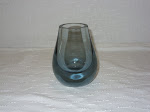
Pontil: an attribute of blown glass. When blown glass pieces are made, they are attached to a rod held by the glassmaker called a "pontil rod". The pontil rod is usually four or five feet long, with a dab of molten glass on the end; this sticks to the bottom of a hot glass piece as it is formed, allowing the glassmaker to manipulate the glass. When the finished glass is snapped off the pontil rod, this leaves a rough spot, usually on the base of the glass, called a pontil (or a punty or pontil mark). A rough pontil is the term used for the unfinished spot before it is polished shown above A rough pontil also may be called an open pontil. A smooth pontil is the term applied to the rough area after it is ground, leaving a circular depression (above, top left photo). A smooth pontil is sometimes referred to as a ground pontil. Smooth pontils also may be polished: this means that a rough pontil was ground and the pontil area then highly polished to neaten the original pontil mark . Smooth, polished pontils are often found on expensive glassware. The presence of a pontil of a particular kind sometimes helps establish the age or authenticity of an antique glass piece.
Top photo you will see the finish pontils on a tangerine bark effect 9689/Lilac lobed 9775/Aqua Knobbly 9856. Below that are Ruby swan/ Mallet vase 9818/ Gold swan, all have a ripple effect but polished flat base.then below this are An Aqua 9571/Tangerine 9566/Lobed 9727 all with smooth polished pontils. The last photo are finshed pontils to a Ruby Finger vase 9729/ And a Meadow Coffin vase 9686, both are smooth and polished which as left the ripple effect to the base.
So as you can see not all Whitefriars Glass will have the ground out polished pontil, as some people tend to think if there is as a ground out polished pontil it is WhiteFriars Glass, not so as other companys followed this production method too.
Email me!







































No comments:
Post a Comment